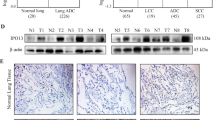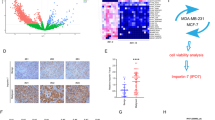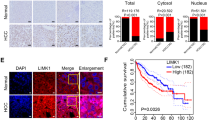Abstract
IGFBP-2 is highly expressed in both the serum and tumor tissues of most cancers, and is considered one of the most significant genes in the signature of major cancers. IGFBP-2 mainly modulates IGF actions in the pericellular space; however, there is considerable evidence to suggest that IGFBP-2 may also act independently of the IGFs. These IGF-independent actions of IGFBP-2 are exerted either via interactions at the cell surface or intracellularly, via interaction with cytoplasmic or nuclear-binding partners. The precise mechanism underlying the intracellular/intranuclear localization of IGFBP-2 remains unclear. In this study, we investigated IGFBP-2 nuclear localization in several common cancer cells with the aim of dissecting the mechanism of its nuclear trafficking. IGFBP-2 is detected in the nuclei of common cancer cells, including breast, prostate and several neuroblastoma cell lines, using cell fractionation and confocal microscopy. Via nuclear import assays, we show that nuclear entry of IGFBP-2 is mediated by the classical nuclear import mechanisms, primarily through importin-α, as demonstrated by the use of blocking, competition and co-immunoprecipitation assays. Bioinformatics analysis of the IGFBP-2 protein sequence with PSORT II identified a classical nuclear localization signal (cNLS) sequence at 179PKKLRPP185, within the IGFBP-2 linker domain, mutagenesis of which abolishes IGFBP-2 nuclear import. Accordingly, the NLSmutIGFBP-2 fails to activate the VEGF promoter, which would otherwise occur in the presence of wild-type IGFBP-2. As a consequence, no activation of angiogenic processes were observed in NLSmutIGFBP-2 expressing SHEP cells when implanted onto our in vivo quail chorio-allantoic membrane model. Taken together, these data show for the first time that IGFBP-2 possesses a functional NLS sequence and that IGFBP-2 actively translocates into the nucleus by a classical nuclear import mechanism, involving formation of IGFBP-2 complexes with importin-α. Nuclear IGFBP-2 is required for the activation of VEGF expression and consequent angiogenesis.
This is a preview of subscription content, access via your institution
Access options
Subscribe to this journal
Receive 50 print issues and online access
$259.00 per year
only $5.18 per issue
Buy this article
- Purchase on Springer Link
- Instant access to full article PDF
Prices may be subject to local taxes which are calculated during checkout









Similar content being viewed by others
References
Firth SM, Baxter RC . Cellular actions of the insulin-like growth factor binding proteins. Endocr Rev 2002; 23: 824–854.
Jones JI, Clemmons DR . Insulin-like growth factors and their binding proteins: biological actions. Endocr Rev 1995; 16: 3–34.
Cohen P, Peehl DM, Stamey TA, Wilson KF, Clemmons DR, Rosenfeld RG . Elevated levels of insulin-like growth factor-binding protein-2 in the serum of prostate cancer patients. J Clin Endocrinol Metab 1993; 76: 1031–1035.
Busund LT, Richardsen E, Busund R, Ukkonen T, Bjornsen T, Busch C et al. Significant expression of igfbp2 in breast cancer compared with benign lesions. J Clin Pathol 2005; 58: 361–366.
So AI, Levitt RJ, Eigl B, Fazli L, Muramaki M, Leung S et al. Insulin-like growth factor binding protein-2 is a novel therapeutic target associated with breast cancer. Clin Cancer Res 2008; 14: 6944–6954.
Fuller GN, Rhee CH, Hess KR, Caskey LS, Wang R, Bruner JM et al. Reactivation of insulin-like growth factor binding protein 2 expression in glioblastoma multiforme: a revelation by parallel gene expression profiling. Cancer Res 1999; 59: 4228–4232.
Song SW, Fuller GN, Khan A, Kong S, Shen W, Taylor E et al. Iip45, an insulin-like growth factor binding protein 2 (igfbp-2) binding protein, antagonizes igfbp-2 stimulation of glioma cell invasion. Proc Natl Acad Sci USA 2003; 100: 13970–13975.
Wang H, Shen W, Huang H, Hu L, Ramdas L, Zhou YH et al. Insulin-like growth factor binding protein 2 enhances glioblastoma invasion by activating invasion-enhancing genes. Cancer Res 2003; 63: 4315–4321.
Elmlinger MW, Deininger MH, Schuett BS, Meyermann R, Duffner F, Grote EH et al. In vivo expression of insulin-like growth factor-binding protein-2 in human gliomas increases with the tumor grade. Endocrinology 2001; 142: 1652–1658.
Moore MG, Wetterau LA, Francis MJ, Peehl DM, Cohen P . Novel stimulatory role for insulin-like growth factor binding protein-2 in prostate cancer cells. Int J Cancer 2003; 105: 14–19.
Flyvbjerg A, Mogensen O, Mogensen B, Nielsen OS . Elevated serum insulin-like growth factor-binding protein 2 (igfbp-2) and decreased igfbp-3 in epithelial ovarian cancer: correlation with cancer antigen 125 and tumor-associated trypsin inhibitor. J Clin Endocrinol Metab 1997; 82: 2308–2313.
Pereira JJ, Meyer T, Docherty SE, Reid HH, Marshall J, Thompson EW et al. Bimolecular interaction of insulin-like growth factor (igf) binding protein-2 with alphavbeta3 negatively modulates igf-i-mediated migration and tumor growth. Cancer Res 2004; 64: 977–984.
Fukushima T, Tezuka T, Shimomura T, Nakano S, Kataoka H . Silencing of insulin-like growth factor-binding protein-2 in human glioblastoma cells reduces both invasiveness and expression of progression-associated gene cd24. J Biol Chem 2007; 282: 18634–18644.
Oh Y, Yamanaka Y, Kim HS, Vorwerk P, Wilson E, Hwa V et al. Igf-independent actions of igfbps. In: Takano K, Hizuka N, Takahashi SI, (eds) Molecular Mechanisms to Regulate the Activities of Insulin-like Growth Factors. Elsevier Science Bv, Amsterdam, 1998, pp 125–133.
Mohan S, Baylink DJ . Igf-binding proteins are multifunctional and act via igf-dependent and -independent mechanisms. J Endocrinol 2002; 175: 19–31.
Russo VC, Bach LA, Fosang AJ, Baker NL, Werther GA . Insulin-like growth factor binding protein-2 binds to cell surface proteoglycans in the rat brain olfactory bulb. Endocrinology 1997; 138: 4858–4867.
Russo VC, Schutt BS, Andaloro E, Ymer SI, Hoeflich A, Fosang A et al. Igfbp-2/igf-i/Proteoglycan Complexes in the Rat Brain Olfactory Bulb. 12th International Congress of Endocrinology Medimont International Proceedings 2004, ISBN 88-7587-071-3(CD ISBN 88-7587-072-1 817–820.
Perks CM, Newcomb PV, Norman MR, Holly JM . Effect of insulin-like growth factor binding protein-1 on integrin signalling and the induction of apoptosis in human breast cancer cells. J Mol Endocrinol 1999; 22: 141–150.
Schutt B, Langkamp M, Rauschnabel U, Ranke M, Elmlinger M . Integrin-mediated action of insulin-like growth factor binding protein-2 in tumor cells. J Mol Endocrinol 2004; 32: 859–868.
Terrien X, Bonvin E, Corroyer S, Tabary O, Clement A, Henrion Caude A . Intracellular colocalization and interaction of igf-binding protein-2 with the cyclin-dependent kinase inhibitor p21cip1/waf1 during growth inhibition. Biochem J 2005; 392: 457–465.
Miyako K, Cobb LJ, Francis M, Huang A, Peng B, Pintar JE et al. Papa-1 is a nuclear binding partner of igfbp-2 and modulates its growth-promoting actions. Mol Endocrinol 2009; 23: 169–175.
Besnard V, Corroyer S, Trugnan G, Chadelat K, Nabeyrat E, Cazals V et al. Distinct patterns of insulin-like growth factor binding protein (igfbp)-2 and igfbp-3 expression in oxidant exposed lung epithelial cells. Biochim Biophys Acta 2001; 1538: 47–58.
Azar WJ, Azar SHX, Higgins S, Hu JF, Hoffman AR, Newgreen DF et al. Igfbp-2 enhances vegf gene promoter activity and consequent promotion of angiogenesis by neuroblastoma cells. Endocrinology 2011; 152: 3332–3342.
Hoeflich A, Reisinger R, Schuett BS, Elmlinger MW, Russo VC, Vargas GA et al. Peri/nuclear localization of intact insulin-like growth factor binding protein-2 and a distinct carboxyl-terminal igfbp-2 fragment in vivo. Biochem Biophys Res Commun 2004; 324: 705–710.
Gorlich D, Mattaj IW . Protein kinesis—nucleocytoplasmic transport. Science 1996; 271: 1513–1518.
Mattaj IW, Englmeier L . Nucleocytoplasmic transport: the soluble phase. Annu Rev Biochem 1998; 67: 265–306.
Dingwall C, Laskey RA . Nuclear targeting sequences—a consensus. Trends Biochem Sci 1991; 16: 478–481.
Kalderon D, Roberts BL, Richardson WD, Smith AE . A short amino-acid sequence able to specify nuclear location. Cell 1984; 39: 499–509.
Kalderon D, Richardson WD, Markham AF, Smith AE . Sequence requirements for nuclear location of simian virus-40 large-t-antigen. Nature 1984; 311: 33–38.
Robbins J, Dilworth SM, Laskey RA, Dingwall C . 2 interdependent basic domains in nucleoplasmin nuclear targeting sequence—identification of a class of bipartite nuclear targeting sequence. Cell 1991; 64: 615–623.
Chook YM, Blobel G . Karyopherins and nuclear import. Curr Opin Struct Biol 2001; 11: 703–715.
Cingolani G, Bednenko J, Gillespie MT, Gerace L . Molecular basis for the recognition of a nonclassical nuclear localization signal by importin beta. Mol Cell 2002; 10: 1345–1353.
Catimel B, Teh T, Fontes MRM, Jennings IG, Jans DA, Howlett GJ et al. Biophysical characterization of interactions involving importin-alpha during nuclear import. J Biol Chem 2001; 276: 34189–34198.
Schedlich LJ, O’Han MK, Leong GM, Baxter RC . Insulin-like growth factor binding protein-3 prevents retinoid receptor heterodimerization: implications for retinoic acid-sensitivity in human breast cancer cells. Biochem Biophys Res Commun 2004; 314: 83–88.
Schedlich LJ, Muthukaruppan A, O’Han MK, Baxter RC . Insulin-like growth factor binding protein-5 interacts with the vitamin d receptor and modulates the vitamin d response in osteoblasts. Mol Endocrinol 2007; 21: 2378–2390.
Schedlich LJ, Young TF, Firth SM, Baxter RC . Insulin-like growth factor-binding protein (igfbp)-3 and igfbp-5 share a common nuclear transport pathway in t47d human breast carcinoma cells. J Biol Chem 1998; 273: 18347–18352.
Schedlich LJ, Le Page SL, Firth SM, Briggs LJ, Jans DA, Baxter RC . Nuclear import of insulin-like growth factor-binding protein-3 and -5 is mediated by the importin beta subunit [in process citation]. J Biol Chem 2000; 275: 23462–23470.
Iosef C, Gkourasas T, Jia CYH, Li SS-C, Han VKM . A functional nuclear localization signal in insulin-like growth factor binding protein-6 mediates its nuclear import. Endocrinology 2008; 149: 1214–1226.
Chi NC, Adam EJH, Adam SA . Sequence and characterization of cytoplasmic nuclear-protein import factor p97. J Cell Biol 1995; 130: 265–274.
Kehlenbach RH, Dickmanns A, Gerace L . Nucleocytoplasmic shuttling factors including ran and crm1 mediate nuclear export of nfat in vitro. J Cell Biol 1998; 141: 863–874.
Ivanova IA, Vespa A, Dagnino L . A novel mechanism of e2f1 regulation via nucleocytoplasmic shuttling—determinants of nuclear import and export. Cell Cycle 2007; 6: 2186–2195.
Nakai K, Horton P . Psort: a program for detecting sorting signals in proteins and predicting their subcellular localization. Trends Biochem Sci 1999; 24: 34–35.
Richardson WD, Roberts BL, Smith AE . Nuclear location signals in polyoma-virus large-t. Cell 1986; 44: 77–85.
Dang CV, Lee WMF . Identification of the human c-myc protein nuclear translocation signal. Mol Cell Biol 1988; 8: 4048–4054.
Chida K, Vogt PK . Nuclear translocation of viral Jun but not of cellular Jun is cell cycle dependent. PNAS 1992; 89: 4290–4292.
Tagawa T, Kuroki T, Vogt PK, Chida K . The cell cycle-dependent nuclear import of v-Jun is regulated by phosphorylation of a serine adjacent to the nuclearlocalization signal. J Cell Biol 1995; 130: 255–263.
Forwood JK, Lam MHC, Jans DA . Nuclear import of creb and ap-1 transcription factors requires importin-beta 1 and ran but is independent of importin-alpha. Biochemistry 2001; 40: 5208–5217.
Rivera J, Megias D, Navas C, Bravo J . Identification of essential sequences for cellular localization in brms1 metastasis suppressor. Plos One 2009; 4: e6433.
Koike M, Ikuta T, Miyasaka T, Shiomi T . Ku80 can translocate to the nucleus independent of the translocation of Ku70 using its own nuclear localization signal. Oncogene 1999; 18: 7495–7505.
Imamura T, Engleka K, Zhan X, Tokita Y, Forough R, Roeder D et al. Recovery of mitogenic activity of a growth factor mutant with a nuclear translocation sequence. Science 1990; 249: 1567–1570.
Imamura T, Tokita Y, Mitsui Y . Identification of a heparin-binding growth factor-1 nuclear translocation sequence by deletion mutation analysis. J Biol Chem 1992; 267: 5676–5679.
Chelsky D, Ralph R, Jonak G . Sequence requirements for synthetic peptide-mediated translocation to the nucleus. Mol Cell Biol 1989; 9: 2487–2492.
Lange A, Mills RE, Lange CJ, Stewart M, Devine SE, Corbett AH . Classical nuclear localization signals: definition, function, and interaction with importin alpha. J Biol Chem 2007; 282: 5101–5105.
Russo VC, Schutt BS, Andaloro E, Ymer SI, Hoeflich A, Ranke MB et al. Insulin-like growth factor binding protein-2 binding to extracellular matrix plays a critical role in neuroblastoma cell proliferation, migration, and invasion. Endocrinology 2005; 146: 4445–4455.
Mukhopadhyay D, Knebelmann B, Cohen HT, Ananth S, Sukhatme VP . The von hippel-lindau tumor suppressor gene product interacts with sp1 to repress vascular endothelial growth factor promoter activity. Mol Cell Biol 1997; 17: 5629–5639.
Ben-Shmuel A, Shvab A, Gavert N, Brabletz T, Ben-Ze’ev A . Global analysis of l1-transcriptomes identified igfbp-2as a target of ezrin and nf-kappab signaling that promotes colon cancer progression. Oncogene 2012; 6: 340.
Marfori M, Lonhienne TG, Forwood JK, Kobe B . Structural basis of high-affinity nuclear localization signal interactions with importin-a. Traffic 2012; 13: 532–548.
Russo VC, Bach LA, Werther GA . Cell membrane association of insulin-like growth factor binding protein-2 (igfbp-2) in the rat brain olfactory bulb. Prog Growth Factor Res 1995; 6: 329–336.
Shen X, Xi G, Maile LA, Wai C, Rosen CJ, Clemmons DR . Insulin-like growth factor binding protein-2 functions coordinately with receptor protein tyrosine phosphatase beta and the igf-i receptor to regulate igf-i-stimulated signaling. Mol Cell Biol 2012; 32: 4116–4130.
Zhou GL, Doci CL, Lingen MW . Identification and functional analysis of nol7 nuclear and nucleolar localization signals. BMC Cell Biol 2010; 11: 74.
Lufei CC, Cao XM . Nuclear import of pin1 is mediated by a novel sequence in the ppiase domain. FEBS Lett 2009; 583: 271–276.
Breeuwer M, Goldfarb DS . Facilitated nuclear transport of histone h1 and other small nucleophilic proteins. Cell 1990; 60: 999–1008.
Gorlich D, Prehn S, Laskey RA, Hartmann E . Isolation of a protein that is essential for the first step of nuclear-protein import. Cell 1994; 79: 767–778.
Adam EJH, Adam SA . Identification of cytosolic factors required for nuclear location sequence-mediated binding to the nuclear-envelope. J Cell Biol 1994; 125: 547–555.
Forwood JK, Harley V, Jans DA . The c-terminal nuclear localization signal of the sex determining region y (sry) high mobility group domain mediates nuclear import through beta 1. J Biol Chem 2001; 276: 46575–46582.
Forwood JK, Harley V, Jans DA . The c-terminal nuclear localisation signal of the sry hmg domain mediates nuclear import through importin beta. Mol Biol Cell 2001; 12: 500A-A.
Lee SJ, Matsuura Y, Liu SM, Stewart M . Structural basis for nuclear import complex dissociation by rangtp. Nature 2005; 435: 693–696.
Russo VC, Gluckman P, Feldman EL, Werther GA . The insulin-like growth factor system and its pleiotropic functions in brain. Endocr Rev 2005; 26: 916–943.
Firth SM, Ganeshprasad U, Baxter RC . Structural determinants of ligand and cell surface binding of insulin-like growth factor-binding protein-3. J Biol Chem 1998; 273: 2631–2638.
Twigg SM, Baxter RC . Insulin-like growth factor (igf)-binding protein 5 forms an alternative ternary complex with igfs and the acid-labile subunit. J Biol Chem 1998; 273: 6074–6079.
Firth SM, Clemmons DR, Baxter RC . Mutagenesis of basic amino acids in the carboxyl-terminal region of insulin-like growth factor binding protein-5 affects acid-labile subunit binding. Endocrinology 2001; 142: 2147.
Weinzimer SA, Gibson TB, Collett-Solberg PF, Khare A, Liu B, Cohen P . Transferrin is an insulin-like growth factor-binding protein-3 binding protein. J Clin Endocrinol Metab 2001; 86: 1806–1813.
Nam TJ, Busby W, Clemmons DR . Insulin-like growth factor binding protein-5 binds to plasminogen activator inhibitor-i. Endocrinology 1997; 138: 2972–2978.
Booth BA, Boes M, Andress DL, Dake BL, Kiefer MC, Maack C et al. Igfbp-3 and igfbp-5 association with endothelial cells: role of c-terminal heparin binding domain. Growth Regul 1995; 5: 1–17.
Hodel MR, Corbett AH, Hodel AE . Dissection of a nuclear localization signal. J Biol Chem 2001; 276: 1317–1325.
Hodel AE, Harreman MT, Pulliam KF, Harben ME, Holmes JS, Hodel MR et al. Nuclear localization signal receptor affinity correlates with in vivo localization in saccharomyces cerevisiae. J Biol Chem 2006; 281: 23545–23556.
Dubois V, Couissi D, Schonne E, Schneider YJ, Remacle C, Trouet A . Estrogen and insulin modulation of intracellular insulin-like growth factor binding proteins in human breast cancer cells: possible involvement in lysosomal hydrolases oversecretion. Biochem Biophys Res Commun 1993; 192: 295–301.
Butt AJ, Dickson KA, McDougall F, Baxter RC . Insulin-like growth factor-binding protein-5 inhibits the growth of human breast cancer cells in vitro and in vivo. J Biol Chem 2003; 278: 29676–29685.
Higgins S, Wong SHX, Richner M, Rowe CL, Newgreen DF, Werther GA et al. Fibroblast growth factor 2 reactivates g1 checkpoint in sk-n-mc cells via regulation of p21, inhibitor of differentiation genes (id1-3), and epithelium-mesenchyme transition-like events. Endocrinology 2009; 150: 4044–4055.
Acknowledgements
We wish to thank Professor Dev Mukhopadhyay (Mayo Clinic, Rochester, MN, USA) for kindly supplying the VEGF constructs used in these studies, Dr Mark Denham (Neuroscience, University of Melbourne) for his assistance in developing the GFP-SHEP cells clones, Dr Donald Newgreen (MCRI) for his assistance in developing CAM assays and Dr Sheena Azar for constant assistance during manuscript preparation. This work was supported by the National Health and Medical Research Council (NHMRC) of Australia Project Grants 1008062 (to GAW and VCR). WJA is the recipient of a Melbourne University (MRS) PhD scholarship.
Author information
Authors and Affiliations
Corresponding author
Ethics declarations
Competing interests
The authors declare no conflict of interest.
Additional information
Supplementary Information accompanies this paper on the Oncogene website
Supplementary information
Rights and permissions
About this article
Cite this article
Azar, W., Zivkovic, S., Werther, G. et al. IGFBP-2 nuclear translocation is mediated by a functional NLS sequence and is essential for its pro-tumorigenic actions in cancer cells. Oncogene 33, 578–588 (2014). https://doi.org/10.1038/onc.2012.630
Received:
Revised:
Accepted:
Published:
Issue Date:
DOI: https://doi.org/10.1038/onc.2012.630
Keywords
This article is cited by
-
IGFBP2 promotes proliferation and cell migration through STAT3 signaling in Sonic hedgehog medulloblastoma
Acta Neuropathologica Communications (2023)
-
IGFBP2: integrative hub of developmental and oncogenic signaling network
Oncogene (2020)
-
Activation of EGFR-DNA-PKcs pathway by IGFBP2 protects esophageal adenocarcinoma cells from acidic bile salts-induced DNA damage
Journal of Experimental & Clinical Cancer Research (2019)
-
Serum IGF-binding protein 2 (IGFBP-2) concentrations change early after gastric bypass bariatric surgery revealing a possible marker of leptin sensitivity in obese subjects
Endocrine (2019)
-
IGFBP2 potentiates nuclear EGFR–STAT3 signaling
Oncogene (2016)



